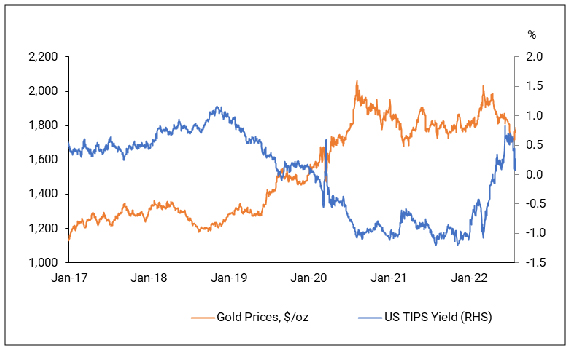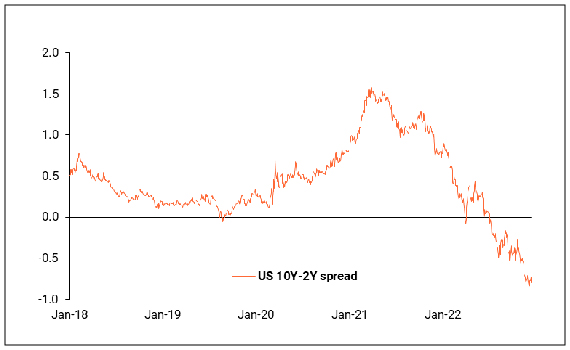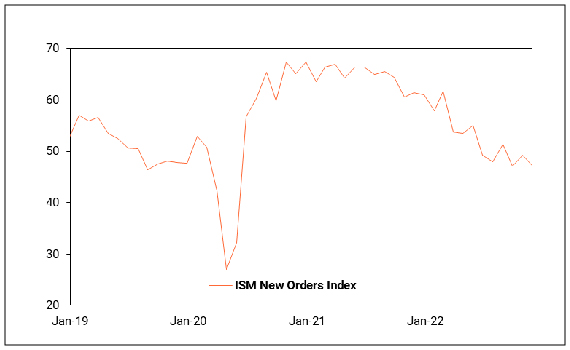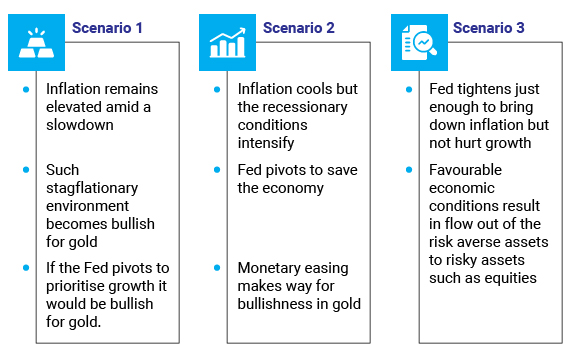Gold Year-End Outlook 2023
Posted On Thursday, Dec 22, 2022
The year 2022 was a challenging one for the global economy in all aspects from the Russia-Ukraine war to four-decade-high inflation in the developed world leading to heightened volatility in financial markets. International gold prices also underwent significant push and pull due to the confluence of factors that affected all asset classes. Gold prices approached an all-time high of around $2,070 in March on the back of risk aversion triggered by the Russia-Ukraine war. But later, as the geopolitical risk premium waned coupled with the Federal Reserve’s tightening spree to combat sky-high inflation, prices faced heavy downside pressure.
Chart 1: Rising US real yields impacted gold prices in 2022

Past performance may or may not be sustained in the future.
The Central bank started hiking rates in March and took rates from 0.25% in March to 4.5% by December. The Fed also initiated the unwinding of its $9 trillion balance sheet by $95 billion a month since October. This rapid pace of tightening resulted in the flight of money from risky assets to the US dollar as the real interest rates (indicated by US 10Y Treasury Inflation Protected Securities) turned positive for the first time in two years in May 2022. This led to a sell-off in gold taking prices down to a two-and-a-half-year low of $1,614. However, as inflation started to moderate sequentially in Q4 2022, investors started anticipating a less aggressive Fed in 2023, and the dollar came under pressure helping gold prices to scale back up. Risk assets too saw a relief rally.
Stepping into 2023, we can’t be sure if this reaction is justified given that inflation in the US remains well above the Fed’s 2% target, and the Fed has made it clear that while the pace of rate hikes could slow down from hereon, but the slower pace does not mean lower rates which the markets had started anticipating. The terminal rate is expected to be higher than previously expected at above 5% as per the dot plot after the FOMC meeting in December. This translates into another 50-75 basis points of hikes in 1H 2023, which could result in bouts of volatility in both risk assets and gold as real rates rise in an environment of cooling inflation and higher nominal rates.
Complicating the inflation trajectory is the Russia-Ukraine war, which is in its 10th month and shows no signs of easing, and the potential opening of China after three years of strict Covid-19 restrictions which could ignite its economy. A combination of this could further fan the inflation fire, leaving no choice for policymakers but to press harder on the tightening brakes to bring down demand-side pressures on inflation. Thus, negative surprises on the Fed policy rate cannot be ruled out.
However, given the fluidity of the external environment, the Fed's commitment to higher rates can get altered quickly on the first signs of recession. Given the lagged effects of the massive 500-basis point tightening in just a year, a recession in the US looks likely by mid-2023.
Chart 2: Negative yield spreads indicate a recession probability

Past performance may or may not be sustained in the future.
Most forward-looking indicators like the 10y-2y yield spread curve and ISM new orders index are flashing recession signals. The New Orders Index dropped below 40 during the recession period of the early-2000s and dropped below 30 during the 2007-2009 Global Financial Crisis and the 2020 COVID lockdowns. We expect that it will keep sliding into the next year. Manufacturing, housing, and consumer sentiment in the US are showing signs of slowing. The monetary inflation rate is also set to remain in a downward trend until at least a few months into 2023 depriving hopes of support for the economy and markets. Unlike 2022 when the anticipation of a slowdown was celebrated by markets as a nudge for Fed to turn dovish, 2023 will bring the slowdown into reality, hurting risk assets. The resulting risk aversion will be positive for gold.
Chart 3: Declining new orders point to a slowdown in the US

Depending on how long and how deep the downturn turns out to be, and how inflation shapes up, the Fed could either stop tightening but keep conditions restrictive or pivot to cut rates later in 2023 to support growth. Our sense is that there could be material deterioration in economic data and thereby in stock markets by end of Q1/ beginning of Q2 of next year, which will hit Feds' resolve to continue tightening. In a scenario where inflation remains somewhat elevated due to any further reason say China reopening / conflict or any other geopolitics, the Fed could keep conditions restrictive even amid a slowdown. This stagflationary environment will be bullish for gold. And if the Fed caves in as a response to slower growth amidst sticky inflation, it could be incredibly bullish for gold.
In another scenario where inflation cools amid recessionary conditions and favourable base effects, gold will still benefit as the Fed pivots and the dollar depreciates. Post which both risk assets and gold are likely to do well as monetary conditions become conducive again, with risk assets leading gold. However, it will also depend on how bad the impact on the economy is and how much the Fed will be able to support given the criticism of pumping too much liquidity post-Covid.
In the unlikely scenario of the Fed achieving a soft landing for the US economy, where inflation cools and growth doesn’t falter, risk assets will prevail over gold.
Chart 4: Probable scenarios for Gold in 2023

Also influencing the returns of Indian gold investors will be the trajectory of the Indian Rupee which is likely to be under pressure in an environment where the Fed is expected to hike further, albeit, at a slower pace, RBI policy cycle is near peaking, recession-induced risk aversion could drive foreign money home, and higher commodity prices threaten to push up the import bill. This will be positive for domestic gold prices.
All in all, gold will be a relevant asset class in 2023. Given that it is currently trading 10-15% below its all-time high levels and could benefit if risk aversion gathers steam as a response to slowing growth, one can consider investing now to build their 15-20% exposure.
Disclaimer, Statutory Details & Risk Factors:The views expressed here in this article / video are for general information and reading purpose only and do not constitute any guidelines and recommendations on any course of action to be followed by the reader. Quantum AMC / Quantum Mutual Fund is not guaranteeing / offering / communicating any indicative yield on investments made in the scheme(s). The views are not meant to serve as a professional guide / investment advice / intended to be an offer or solicitation for the purchase or sale of any financial product or instrument or mutual fund units for the reader. The article has been prepared on the basis of publicly available information, internally developed data and other sources believed to be reliable. Whilst no action has been solicited based upon the information provided herein, due care has been taken to ensure that the facts are accurate and views given are fair and reasonable as on date. Readers of this article should rely on information/data arising out of their own investigations and advised to seek independent professional advice and arrive at an informed decision before making any investments. Mutual fund investments are subject to market risks read all scheme related documents carefully.Please visit – www.QuantumAMC.com to read scheme specific risk factors. Investors in the Scheme(s) are not being offered a guaranteed or assured rate of return and there can be no assurance that the schemes objective will be achieved and the NAV of the scheme(s) may go up and down depending upon the factors and forces affecting securities market. Investment in mutual fund units involves investment risk such as trading volumes, settlement risk, liquidity risk, default risk including possible loss of capital. Past performance of the sponsor / AMC / Mutual Fund does not indicate the future performance of the Scheme(s). Statutory Details: Quantum Mutual Fund (the Fund) has been constituted as a Trust under the Indian Trusts Act, 1882. Sponsor: Quantum Advisors Private Limited. (liability of Sponsor limited to Rs. 1,00,000/-) Trustee: Quantum Trustee Company Private Limited. Investment Manager: Quantum Asset Management Company Private Limited. The Sponsor, Trustee and Investment Manager are incorporated under the Companies Act, 1956. |
Related Posts
-

Gold Monthly View for March 2025
Posted On Tuesday, Apr 08, 2025
After experiencing a surge of approximately 9% in 2025 through the end of February, gold prices further increased by an additional 9% in March, bringing year-to-date returns to around 19%.
Read More -

Gold Monthly View for February 2025
Posted On Friday, Mar 07, 2025
The bullish momentum for gold carried on into February 2025, with spot prices maintaining
Read More -

Gold Monthly View for January 2025
Posted On Friday, Feb 07, 2025
In the calendar year 2024, gold demonstrated remarkable performance, yielding a return of ~ 27%.
Read More



